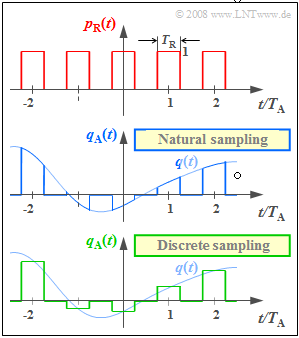Exercise 4.3: Natural and Discrete Sampling
Ideal sampling can be described in the time domain by multiplying the analog source signal $q(t)$ by a Dirac comb $p_δ(t)$ :
- $$ q_{\rm A}(t) = p_{\delta}(t) \cdot q(t) \hspace{0.05cm}.$$
Dirac combs- infinitely narrow and infinitely high - and accordingly also the Dirac comb $p_δ(t)$ cannot be realized in practice, however. Here we must assume instead the square pulse $p_{\rm R}(t)$ where the following relation holds:
- $$ p_{\rm R}(t) = \left [ \frac{1}{T_{\rm A}} \cdot p_{\rm \delta}(t) \right ]\star g_{\rm R}(t)\hspace{0.9cm}\text{with}\hspace{0.9cm} g_{\rm R}(t) = \left\{ \begin{array}{l} 1 \\ 1/2 \\ 0 \\ \end{array} \right.\quad \begin{array}{*{5}c}{\rm{for}} \\{\rm{for}} \\{\rm{for}} \end{array}\begin{array}{*{10}c} {\hspace{0.04cm}\left|\hspace{0.06cm} t \hspace{0.05cm} \right|} < T_{\rm R}/2\hspace{0.05cm}, \ {\hspace{0.04cm}\left|\hspace{0.06cm} t \hspace{0.05cm} \right|} = T_{\rm R}/2\hspace{0.05cm}, \ {\hspace{0.005cm}\left|\hspace{0.06cm} t \hspace{0.05cm} \right|} > T_{\rm R}/2\hspace{0.05cm}. \hspace{0.05cm} \end{array}$$
The duration $T_{\rm R}$ of a rectangular pulse $g_{\rm R}(t)$ should be (significantly) smaller than the distance $T_{\rm A}$ of two samples.
In the diagram this ratio is chosen very large with $T_{\rm R}/T_{\rm A} = 0.5$ to make the difference between "natural sampling" and "discrete sampling" especially clear:
- In natural sampling, the sampled signal $q_{\rm A}(t)$ is equal to the product of square pulse $p_{\rm R}(t)$ and analog source signal $q(t)$:
- $$q_{\rm A}(t) = p_{\rm R}(t) \cdot q(t) = \left [ \frac{1}{T_{\rm A}} \cdot p_{\rm \delta}(t) \star g_{\rm R}(t)\right ]\cdot q(t)\hspace{0.05cm}.$$
- In contrast, the corresponding equation for discrete sampling is:
- $$ q_{\rm A}(t) = \left [ \frac{1}{T_{\rm A}} \cdot p_{\rm \delta}(t) \cdot q(t)\right ]\star g_{\rm R}(t)\hspace{0.05cm}.$$
In the graph, these signals are sketched in blue (natural sampling) and green (discrete sampling) respectively.
For signal reconstruction, a rectangular low-pass filter $H(f)$ with cutoff frequency $f_{\rm G} = f_{\rm A}/2$ and gain $T_{\rm A}/T_{\rm R}$ is used in the passband:
- $$H(f) = \left\{ \begin{array}{l} T_{\rm A}/T_{\rm R} \ 0 \end{array} \right.\quad \begin{array}{*{5}c}{\rm{for}} \\{\rm{for}} \end{array}\begin{array}{*{10}c} {\hspace{0.04cm}\left| \hspace{0.005cm} f\hspace{0.05cm} \right| < f_{\rm A}/2}\hspace{0.05cm}, \ {\hspace{0.04cm}\left| \hspace{0.005cm} f\hspace{0.05cm} \right| > f_{\rm A}/2}\hspace{0.05cm}. \end{array}$$
Hints:
- The exercise belongs to the chapter Puls Code Modulation.
- Reference is made in particular to the page Natural and discrete sampling.
- The sampled source signal is denoted by $q_{\rm A}(t)$ and its spectral function by $Q_{\rm A}(f)$.
- Sampling is always performed at $ν \cdot T_{\rm A}$.
Questions
Solution
- $$ G_{\rm R}(f) = T_{\rm R} \cdot {\rm si}(\pi f T_{\rm R}) \hspace{0.3cm} {\rm with}\hspace{0.3cm} {\rm si}(x) = \sin(x)/x \hspace{0.3cm} \rightarrow \hspace{0.3cm} \frac{G_{\rm R}(f)}{T_{\rm A}} = \frac{T_{\rm R}}{T_{\rm A}} \cdot {\rm si}(\pi f T_{\rm R})$$
- $$ \rightarrow \hspace{0.3cm} \frac{G_{\rm R}(f = 0)}{T_{\rm A}} =\frac{T_{\rm R}}{T_{\rm A}}\hspace{0.15cm}\underline { = 0.5} \hspace{0.05cm}.$$
(2) The correct solution is the second suggested solution:
- From the given equation in the time domain, the convolution theorem gives:
- $$q_{\rm A}(t) = \left [ \frac{1}{T_{\rm A}} \cdot p_{\rm \delta}(t) \star g_{\rm R}(t)\right ]\cdot q(t) \hspace{0.3cm} \Rightarrow \hspace{0.3cm}Q_{\rm A}(f) = \left [ \frac{1}{T_{\rm A}}\cdot P_{\rm \delta}(f) \cdot G_{\rm R}(f) \right ] \star Q(f) = \left [ P_{\rm \delta}(f) \cdot \frac{G_{\rm R}(f)}{{T_{\rm A}}} \right ] \star Q(f) \hspace{0.05cm}.$$
- The first proposed solution is valid only for ideal sampling (with a Dirac comb) and the last one for discrete sampling.
(3) The answer is YES:
- Starting from the result of the subtask (2) using the spectral function of the Dirac comb, we obtain.
- $$Q_{\rm A}(f) = \left [ P_{\rm \delta}(f) \cdot \frac{G_{\rm R}(f)}{{T_{\rm A}}} \right ] \star Q(f)= \left [ \frac{G_{\rm R}(f)}{{T_{\rm A}}} \cdot \sum_{\mu = -\infty}^{+\infty} \delta(f - \mu \cdot f_{\rm A})\right ] \star Q(f) \hspace{0.05cm}.$$
- When the sampling theorem is satisfied and the low-pass filter is correct, of the infinite convolution products, only the convolution product with $μ = 0$ lie in the passband.
- Taking into account the gain factor $T_{\rm A}/T_{\rm R}$ we thus obtain for the spectrum at the filter output:
- $$V(f) = \frac{T_{\rm A}}{T_{\rm R}} \cdot \left [ \frac{G_{\rm R}(f = 0)}{{T_{\rm A}} \cdot \delta(f )\right ] \star Q(f)= Q(f) \hspace{0.05cm}.$$
(4) The last suggested solution is correct.
- Shifting the factor $1/T_{\rm A}$ to the rectangular pulse, we obtain with discrete sampling using the convolution theorem:
- $$ q_{\rm A}(t) = \big [ p_{\rm \delta}(t)\cdot q(t) \big ] \star \frac{g_{\rm R}(t)}{T_{\rm A}}\hspace{0.3cm} \Rightarrow \hspace{0.3cm}Q_{\rm A}(f)= \big [ P_{\rm \delta}(f)\star Q(f) \big ] \cdot \frac{G_{\rm R}(f)}{T_{\rm A}}\hspace{0.05cm}.$$
(5) The answer is NO:
- The weighting function $G_{\rm R}(f)$ now involves the inner kernel $(μ = 0)$ of the convolution product.
- All other terms $(μ ≠ 0)$ are eliminated by the low-pass filter. One obtains here in the relevant range $|f| < f_{\rm A}/2$:
- $$V(f) = \frac{T_{\rm A}}{T_{\rm R}} \cdot \frac{G_{\rm R}(f )}{{T_{\rm A}}} \cdot Q(f) = 2 \cdot 0.5 \cdot {\rm si}(\pi f T_{\rm R})\cdot Q(f) \hspace{0.3cm}\Rightarrow \hspace{0.3cm}V(f) = Q(f) \cdot {\rm si}(\pi f T_{\rm R})\hspace{0.05cm}.$$
- If no additional equalization is provided here, the higher frequencies are attenuated according to the $\rm si$ function.
- The highest signal frequency $(f = f_{\rm A}/2)$ is attenuated the most here:
- $$V(f = \frac{f_{\rm A}}{2}) = Q( \frac{f_{\rm A}}{2}) \cdot {\rm si}(\pi \cdot \frac{T_{\rm R}}{2 \cdot T_{\rm A}})= Q( \frac{f_{\rm A}}{2}) \cdot {\rm si}(\pi \cdot \frac{\sin(\pi/4)}{\pi/4})\approx 0.9 \cdot Q( \frac{f_{\rm A}}{2}) \hspace{0.05cm}.$$
